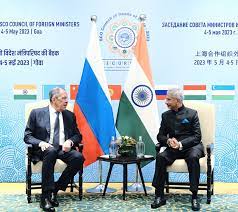
Among the most unexpected effects of the ongoing Russia-Ukraine war has been the metamorphosis of the India-Russia partnership. While for many decades an unwavering commitment toward defence partnership stood as the strongest pillar for the bilateral ties, booming energy trade as sanction-hit Russia offered heavily discounted oil became the new avenue for boosting engagement. However, with supply chain issues mounting for Moscow and the oil trade expected to plateau in the coming months, what lies beyond arms and oil for the Indo-Russian relationship is a crucial question.
The Trade Tale
As Russia emerged as India’s fifth-largest trading partner—crossing the USD 30 billion per year trade target set in 2016 and meant to be achieved by 2025—a new target of USD 50 billion trade per year is now on the radar. The two countries engaged in several important meetings in March 2023, turning it into a milestone month for Indo-Russian ties.
Currently, Moscow is looking for replacing the EU (one of its top trade partners till 2022) for Russian exports and imports. A growing need to attract foreign investment to keep the Russian economy afloat has also been highlighted frequently since last year. Further, to avoid over-dependence on the “no limits friendship” with China, Moscow is looking at New Delhi as a priority trade partner.
During a virtual meeting between the Indian Foreign Minister Jaishankar and the Russian Deputy PM Manturov in early March, the two sides agreed to address the persisting trade deficit and market access issues to boost bilateral trade and economic relations. In another event, the Russian Consul General for South India, Oleg N. Avdeev, underlined that the shortage of information about Russia continues to affect mutual business opportunities for the two sides, stressing that these shortages are technical and can be addressed by increasing engagements between the communities from both sides.
Besides strengthening trade in several areas like agriculture products (e.g., fertilisers), machinery (e.g., small and medium-sized tractors), railways and pharmaceuticals, Moscow is now focusing on partnering with New Delhi in the hi-tech domain. Moreover, as markets for Russian tech offerings and possibilities for tech imports from the West shrink, the Indian market might be considered as an offset against an overwhelming influx of Chinese technologies in Russia.
This is visible through engagements like the Indo-Russian Business Forum, with participation by Russian companies to showcase their offerings in areas like biometric facial recognition, Augmented and Virtual Reality (AR/VR), EdTech solutions for corporate universities, biocomponents, high-performance data collection and storage systems, and cloud solutions.
India’s tech industry is estimated to grow at an impressive rate of 8.4% in 2023. As many multinational firms shift their bases from China, India is expected to become a technology and innovation hub. Considering this, Moscow will seek to benefit from ties with India to compensate for the effects of the war on the Russian tech sector.
The ‘Shift East’
With the East-West global geopolitical balance transforming and the divide with the West deepening, Moscow has seemingly adopted a “Shift East” policy for enhanced engagement with Asian partners.
Moscow now understands that increasing people-to-people links with emerging trade partners will be significant. To bridge the gap, Russia is now simplifying its visa regime while working toward the possibility of visa-free tourist travel between partner countries. For example, in January 2023, Russia launched the Golden Visa programme—a residency programme for foreign investors, expected to attract foreign investment. Another example is the revised India-Russia bilateral air services agreement, which increased the weekly flights between the two countries.
Russia’s “Shift East” also seeks to benefit from the existing regional and multilateral partnerships. By encouraging the expansion of regional frameworks like the Shanghai Cooperation Organisation (SCO) and the Eurasian Economic Union (EAEU), Moscow (along with China) is creating grounds for drawing Iran and the Middle East and North Africa (MENA) closer. Meanwhile, the Chinese diplomatic victory in bridging the Saudi-Irani gap has ensured that this is not a far-fetched idea anymore. For India, too, access to these markets open many new opportunities. In New Delhi’s calculations, an increasingly emerging Chinese monopoly in these markets can only be countered through a cooperative approach till indigenous competitive capabilities are in place. But, again, India’s presence will provide hedging options for Moscow.
Trends ahead
In a rare disclosure, the Indian defence establishment recently remarked that Russia is unable to fulfil its commitments for vital defence supplies to India due to the ongoing war. It has also been emphasised that India has learnt the significance of self-dependence from the Russia-Ukraine war.
As stated recently by India’s Foreign Minister, India needs and is working toward building deep indigenous industrial strengths and technologies.
For Russia, this points to a downturn in its defence partnership with India, emerging from its inability to fulfil commitments, as well as the growing partnerships between India and the West—especially with the Quad partners, France and Israel—as India diversifies its defence base while focusing on indigenous
capabilities.
As the energy trade is much more transactional—with a greater potential for disruption due to market forces—Moscow will want to bridge the deficit to emerge from the defence trade with India. As the oil trade plateaus and then potentially starts slowing down, trade in other sectors can help the Indo-Russian partnership grow.
To this aim, while the cultural connection is necessary, and hi-tech cooperation a crucial aspect for boosting ties, Russia’s deft but swift multilateral manoeuvring will also be geared toward bringing New Delhi closer.

Divyanshu Jindal is a Research Associate at NatStrat, India.